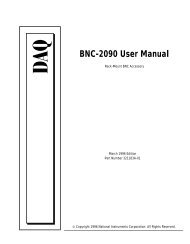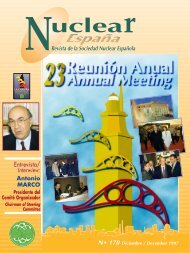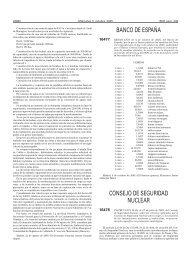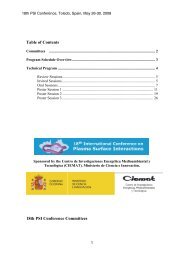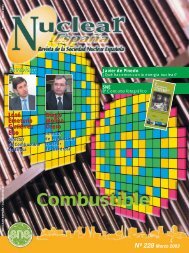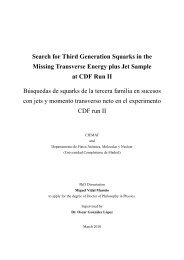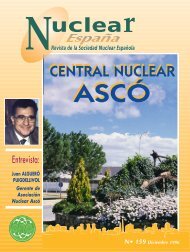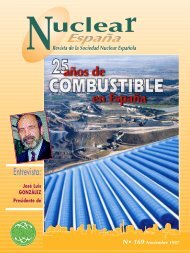EntrEntr evista/evista/ InterInter viewview
EntrEntr evista/evista/ InterInter viewview
EntrEntr evista/evista/ InterInter viewview
You also want an ePaper? Increase the reach of your titles
YUMPU automatically turns print PDFs into web optimized ePapers that Google loves.
DESARROLLO TECNOLÓGICO<br />
la exploración de los márgenes<br />
operacionales, parecen candidatos<br />
claros. Por otro lado, el aumento<br />
de la edad media de las plantillas,<br />
los procesos de rotación de personal,<br />
el alto grado de fiabilidad ya<br />
alcanzado por equipos y componentes<br />
y las dificultades de reclutamiento<br />
de personal adecuado,<br />
obligan a prestar atención a las herramientas<br />
de formación.<br />
Como norma general, en el área<br />
de operación y mantenimiento no<br />
se trata de perseguir grandes invenciones,<br />
sino más bien de aplicar<br />
al campo nuclear tecnologías<br />
ya operativas y exitosas en otros<br />
sectores industriales. La rapidísima<br />
evolución de las llamadas nuevas<br />
tecnologías ofrece un enorme potencial<br />
de aplicación a las CCNN<br />
en la medida en que son capaces<br />
de compatibilizar la reducción de<br />
costes con la minimización de<br />
riesgos y la mejora de los niveles<br />
de formación del personal.<br />
En el área de combustible todo<br />
apunta a la consecución de combustibles<br />
más fiables y resistentes<br />
que mejoren este capítulo de los<br />
costes de explotación, manteniendo<br />
los adecuados márgenes de seguridad.<br />
A largo plazo, los esfuerzos innovadores<br />
se centran en la obtención<br />
de diseños de Centrales<br />
Avanzadas capaces de competir<br />
con otros modos de generación alternativos<br />
en un mercado abierto.<br />
El diseño y construcción de las<br />
centrales nucleares del futuro (en<br />
Estados Unidos se necesitará incrementar<br />
la capacidad instalada en<br />
al menos 200.000 megavatios de<br />
aquí al año 2020, y es difícil imaginar<br />
que parte de estas nuevas<br />
plantas no sean nucleares) se basará<br />
en varias líneas de actuación.<br />
• Modificación del proceso de<br />
licenciamiento que se hará en un<br />
solo paso, antes del inicio de la<br />
construcción, lo que permitirá reducir<br />
los costes asociados a las<br />
modificaciones requeridas, así como<br />
de los plazos de ejecución.<br />
• Desarrollo de técnicas de financiación<br />
innovadoras, que compensen<br />
la penalización sufrida por<br />
proyectos con altas inversiones iniciales.<br />
• Mejora global de los parámetros<br />
de seguridad, y en especial<br />
disminución de la frecuencia de<br />
daño al núcleo.<br />
• Estandarización del diseño e<br />
introducción de nuevas tecnologías<br />
para disponer de plantas más fáciles<br />
de operar y rápidas de construir.<br />
La conveniencia de abordar el<br />
proceso innovador de forma cooperativa<br />
surge también de forma<br />
natural de lo anterior. Esta cooperación<br />
se refiere tanto al nivel sectorial<br />
como nacional e incluso internacional<br />
y es consecuencia de<br />
la complejidad de las tecnologías<br />
involucradas, de la necesidad de<br />
minimizar riesgos tecnológicos y<br />
de compartir riesgos económicos<br />
en un entorno de financiación limitada.<br />
La estrecha vinculación<br />
del usuario final en los proyectos<br />
emprendidos, a la vez que garantiza<br />
la aplicabilidad de los resultados,<br />
también optimiza costes de<br />
desarrollo.<br />
El concepto de competitividad<br />
tiene asimismo una aplicación directa<br />
a la propia gestión de los<br />
proyectos. La disposición de un espectro<br />
suficiente de colaboradores<br />
adecuados desde el punto de vista<br />
técnico y económico, la especificación<br />
detallada de los proyectos<br />
ex-ante y el control ajustado de<br />
plazos, presupuestos y calidades,<br />
redundan en una mayor competitividad<br />
de los productos resultantes.<br />
LA APLICACIîN Y DIFUSIîN<br />
DE LAS TECNOLOGêAS<br />
DISPONIBLES<br />
Con el esquema definido de innovación-competitividad,<br />
el proceso<br />
de identificación y desarrollo de<br />
proyectos de I+D culmina con un<br />
cierre de cada proyecto que incorpora<br />
las condiciones más adecuadas<br />
para su aplicación y comercialización.<br />
El mercado impone un elevado<br />
ritmo de cambio tecnológico y,<br />
por tanto, las aplicaciones ofrecidas<br />
a las plantas deben proporcionar<br />
el valor añadido de una alta<br />
adecuación a sus necesidades<br />
cambiantes con una estructura de<br />
costes claramente favorable. Sin<br />
embargo no se parte de cero: la<br />
experiencia obtenida en actuaciones<br />
anteriores y las conclusiones<br />
recogidas de esa experiencia, aunque<br />
resultantes de un entorno bien<br />
distinto, constituyen un referente<br />
necesario.<br />
Desde el inicio del proceso, deben<br />
hacerse las siguientes consideraciones<br />
pensando en la aplicación<br />
final de los proyectos:<br />
• El cambio tecnológico del entorno<br />
exige una prospección bien<br />
dose and waste on one hand, and on the other improve<br />
plant operating aspects, always seeking an increase in<br />
energy production that is compatible with safety<br />
requirements. Obvious candidates for this are<br />
procurement cost reduction, plant information system<br />
enhancement, maintenance and operational dose<br />
optimization, development of new inspection and repair<br />
techniques, and assessment of operational margins. On<br />
the other hand, attention must be paid to training tools<br />
because of the older average age of staff members,<br />
personnel turnover processes, the high degree of<br />
reliability already achieved by equipment and<br />
components, and the difficulty of recruiting qualified<br />
personnel.<br />
As a general rule, in the area of operation and<br />
maintenance, it is not a matter of pursuing major<br />
inventions, but rather of applying already proven,<br />
successful technologies from other industrial sectors to<br />
the nuclear field. The very fast evolution of the so-called<br />
new technologies offers a tremendous potential for<br />
application to NPPs, in that they are able to reconcile<br />
cost reduction with risk minimization and improved<br />
personnel training levels.<br />
In the area of fuel, everything seems to indicate that<br />
more reliable, resistant fuels will be achieved that will<br />
help to improve this issue of operating costs while<br />
maintaining proper safety margins.<br />
In the long term, innovative efforts will focus on<br />
obtaining Advanced Plant designs capable of competing<br />
with other alternative modes of generation in an open<br />
market.<br />
The design and construction of future nuclear power<br />
plants (in the United States alone, it will be necessary to<br />
increase installed capacity by at least 200,000<br />
megawatts between now and the year 2020, and it is<br />
hard to believe that some of these new plants will not be<br />
nuclear) will be based on several courses of action.<br />
• Modification of the licensing process, which will be<br />
done in a single step before commencing construction,<br />
which will reduce the costs associated with required<br />
modifications and also the execution times.<br />
• Development of innovative financing techniques,<br />
which compensate for the penalties endured by projects<br />
with high initial investments.<br />
• Overall improvement of safety parameters, and in<br />
particular reduced frequency of core damage.<br />
• Design standardization and use of new<br />
technologies to obtain easier-to-operate, quickly built<br />
plants.<br />
The advisability of undertaking the innovative process<br />
on a cooperative basis is a natural result of the above.<br />
This cooperation refers both to the industry and national<br />
levels, and even to the international level, and is a<br />
consequence of the complexity of the technologies<br />
involved and of the need to minimize technological<br />
risks and to share economic risks in an environment of<br />
limited funding. A close relationship with the end user<br />
in any project undertaken will ensure the applicability of<br />
the results and at the same time optimize development<br />
costs.<br />
The concept of competitiveness can also be directly<br />
applied to project management. The availability of a<br />
wide enough range of suitable technical and economic<br />
collaborators, a detailed project specification from the<br />
outset, and tight control of schedules, budgets and<br />
qualities will result in more competitive products.<br />
APPLICATION AND DISSEMINATION OF<br />
AVAILABLE TECHNOLOGIES<br />
With the innovation-competition scheme defined<br />
above, the process of identifying and developing R&D<br />
projects culminates in closure of each project that<br />
includes the most suitable conditions for application<br />
and marketing.<br />
The market dictates a high rate of technological<br />
A b r i l 2 0 0 0<br />
R e v i s t a S N E




